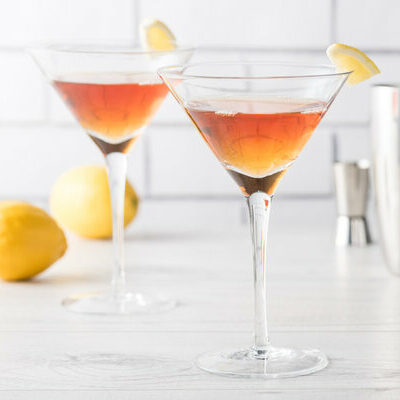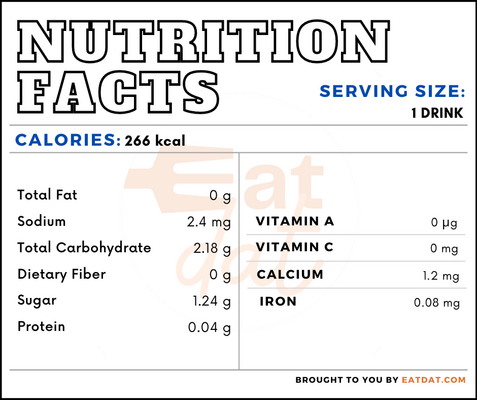
Manhattan
What is a Manhattan?
Manhattan is a cocktail made with whiskey, sweet vermouth, and angostura bitters. This amber colored cocktail has a slight bitter and herbal taste from the bitters and the vermouth, with hints of sweetness. It is served in a ratio of 2:1 of whiskey and vermouth. Changing the ratio of these ingredients lead to different versions of the cocktail.
- The drink is named after the district of Manhattan in New York City, one among five cocktails named after districts in the city.
- Invented in the 1870s, it is one of the oldest cocktails that is still popular today.
Some of the oldest classic cocktails are:
- Old-Fashioned
- Sazerac
- Pisco Sour
- Manhattan
- Mint Julep
- Gin Fizz
- Sidecar
- Gin Rickey
- Aviation
- Blue Blazer
Origin of the manhattan
The most popular origin story is that the this cocktail was invented by Dr. Iain Marshall for Lady Randolph Churchill for a party in New York at a club of the same name. However, Lady Churchill was in England at the time, so this may just be an urban legend. Another story has it that the drink was created by a bartender called Black who had a pub on Broadway. Nonetheless, this cocktail has been around since the 1880s, and was first mentioned in an article in 1882 in the Sunday Morning Herald. The recipe was first printed in an 1884 cookbook called The Modern Bartenders’ Guide by O.H. Byron.
Nutrition
Nutritional profile for Manhattan (1 drink):

In addition, the cocktail contains potassium and phosphorus. Because whiskey is distilled in copper stills, it contains copper, which helps in the creation of red blood cells, absorbs iron, boosts the immune system, protects cells, and prevents the onset of anemia and osteoporosis. Additionally, whiskey contains antioxidants, which help in preventing heart diseases. Also, the drink controls urate levels by promoting excretion of urate through urine, helping to prevent gout and other uric acid diseases.
Furthermore, a unit of 100 ml of vermouth wine with 18.8 mg alcohol contains 220 mg polyphenol compounds. These antioxidants can protect the body against heart diseases, diabetes, and give a general health boost. On the other hand, alcoholic beverages such as vermouth have been found to contain asbestos fibers, which can cause cancer. It is not recommended to drink cocktails on a regular basis. Overconsumption of alcohol can lead to several health problems, so it is recommendable to consume them responsibly and in moderation.
Commercial preparation
To prepare a Manhattan, the main ingredients required are rye whiskey, sweet vermouth, and angostura bitters. Traditionalists insist that the cocktail be prepared with American rye whiskey, but Canadian whiskey and bourbon are acceptable alternatives. First, whiskey and vermouth are added in a 2:1 ratio with 2 dashes of the bitters in a glass filled with ice and stirred well. Then, a maraschino cherry is used for garnish. The cocktail is usually served in a martini glass. A cocktail or coupe glass is also acceptable.
Manhattan recipes
This cocktail is a versatile and has several variations. Here are a few recipes to try:
- Manhattan
- Perfect Manhattan
- Breakfast in Manhattan
- Distrito Federal
- Black Manhattan
- Reverse Manhattan
- Rob Roy
- Cake
- Cheesecake
- Gingerbread
FDA regulations
The Manhattan cocktail is described by the TTB as any cocktail that contains whiskey and vermouth. Whiskey production has to comply with the TTB (Alcohol and Tobacco Tax and Trade Bureau) requirements. The general definition of whiskey is that it is a distilled spirit made from a fermented mash of grain with less than 95% ABV and more than 40% ABV. Vermouth is classified as an aperitif and defined as wine having an alcoholic content of not less than 15 percent by volume, compounded from grape wine containing added brandy or alcohol, flavored with herbs and other natural aromatic flavoring materials.
References
Cocktail History: The Manhattan, Spirit of York Distillery Co., https://spiritofyork.com/cocktail-history-manhattan/#
Mäkelä, Pia et al. “A bottle of beer, a glass of wine or a shot of whiskey? Can the rate of alcohol-induced harm be affected by altering the population’s beverage choices?.” Contemporary drug problems vol. 38,4 (2011): 599-619. doi:10.1177/009145091103800408, https://www.ncbi.nlm.nih.gov/pmc/articles/PMC3888958/
Heart Foundation New Zealand, Alcohol and the Heart, https://www.heartfoundation.org.nz/wellbeing/healthy-eating/nutrition-facts/alcohol-and-the-heart
